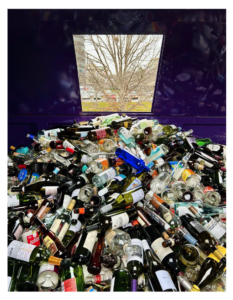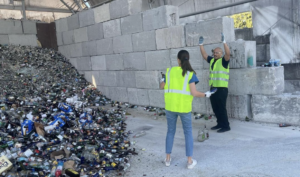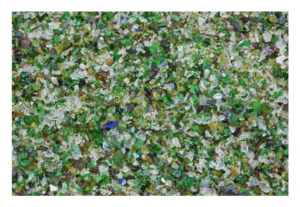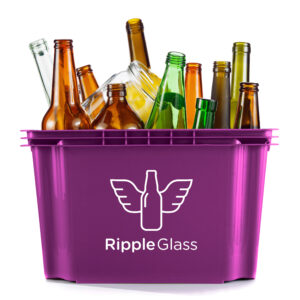
When you toss glass into one of our purple bins, you’re not just saving resources, but you’re also taking a stand against excessive waste production. Curious about how it all happens? Dive into this blog and uncover the captivating life cycle of glass to unlock the secrets of its incredible transformation.
First, Glass Recycling in Four Easy Steps
Glass stands out as the only material that can be recycled indefinitely without losing quality. And it’s easier than you think with our simple four-step process:
- Step 1: Gather all your glass items, from juice bottles to mason jars. Ripple Glass accepts all colors and types. No need to separate them; just make sure they fit in the purple bins!
- Step 2: Next, find a convenient spot at home to store your glass collection. Labels, caps and lids can stay on, and rinsing is optional.
- Step 3: Then, when your collection is ready, drop it off at the nearest Ripple Glass bin. All bins are open to the public and free to use!
- Step 4: Finally, once your glass reaches the Ripple Glass processing facility, it undergoes a thorough cleaning and sorting process. The brown glass ultimately becomes new beer bottles, while the clear and colored glass is turned into sand-like material for eco-friendly fiberglass insulation.
From Bin to New Beginnings: The Glass Recycling Process
Each stage of recycling plays a crucial role in transforming your used glass into a sustainable cycle of renewal. Here’s the process:
- Collection from Recycling Bins: It all begins with you! Once you toss your glass into the recycling bin, the recycling process begins.
- Transportation to Recycling Facility: Off to the Specialists! Ripple trucks pick up the recycled glass and whisk it away to our specialized facility.
- Sorting and Removal of Contaminants: Careful sorting ensures that only pure, high-quality glass moves forward in the process.
- Crushing and Cleaning: Watch as the glass is crushed and cleaned, ultimately transforming into delicate sand, or “cullet.”
- Formation of New Glass Products: Ripple Glass sends its recycled glass to manufacturers to create new fiberglass insulation and glass bottles.
What is Glass Cullet
First things first, let’s talk about glass cullet. Often referred to simply as “cullet,” this sand-like material is recycled glass that has been processed and prepared for reuse in the manufacturing of new glass products. It acts as a sustainable substitute for raw materials, breathing new life into glass that has already served its initial purpose.

Cullet contributes in a few ways:
- Energy Efficiency: It significantly cuts the energy needed for manufacturing, promoting sustainability.
- Circular Integration: Carefully processed, cullet seamlessly blends into the glass manufacturing process, reducing greenhouse gas emissions and contributing to a circular economy.
- Resource Conservation: Cullet’s inclusion in new glass products fosters resource efficiency, aligning with environmental goals for a greener future.
- Innovation Symbol: Beyond its material use, cullet symbolizes innovation and sustainability, transforming recycled glass into an emblem of positive change.
Why We Recycle: Incredible Benefits of Glass Recycling
When we recycle glass, we’re not just reducing waste. We’re making a commitment to the environment and sparking positive change!
We not only save energy, reduce carbon emissions and minimize the need for raw materials, but we also contribute to the circular economy model. This fancy term means we’re using resources for as long as possible, creating a cycle of reuse and regeneration.
Need more inspiration? Check out these amazing stats:
- Recycling glass reduces air pollution by 20% and cuts water pollution by 50% compared to making new glass.
- Every ton of recycled glass saves a whopping 1,300 lbs. of sand, 410 lbs. of soda ash, 380 lbs. of limestone and 150 lbs. of feldspar.
- Using 714 recycled glass bottles produces enough fiberglass insulation to insulate an entire attic space.
- A six-pack of recycled beer bottles can give you enough insulation for a whole wall.
- In 2018 alone, the U.S. produced a whopping 12.3 million tons of glass, contributing to 4.2% of all waste. And get this: only 31.3% was recycled, and 4.8% was burned for energy. That means a staggering 7.6 million tons ended up in landfills. Yikes!
- While some places are crushing it with glass recycling rates close to 90%, the United States average is still around 30%.
How Many Times Can Glass Be Recycled?
On average, glass can be recycled endlessly without losing its quality. It’s a material that thrives on being reused, reshaped and reinvented. This remarkable characteristic stems from its unique properties.
Unlike some materials that might degrade with each recycling round, glass is a champ at holding its own. It’s resistant to the wear and tear that time and recycling usually impose.
With each recycling cycle, glass not only retains its quality but also undergoes a magical transformation. It’s like a phoenix rising from the ashes, but in this case, it’s a bottle turning into a bottle once again!
The recycling process involves crushing and cleaning the glass, giving it a fresh lease on life. By reincarnating glass endlessly, we cut down on the energy and resources needed to create brand-new glass products.

Discover a Purple Bin and Kickstart the Journey
And there you have it – from bin to new beginnings, your glass plays a pivotal role in the circular economy, creating a sustainable loop that benefits both the environment and future generations.
So, the next time you toss a glass bottle into a purple bin, remember that you’re not just giving glass a second life – you’re setting it on a path of perpetual renewal. Find a purple bin today to become a Ripple Maker!
